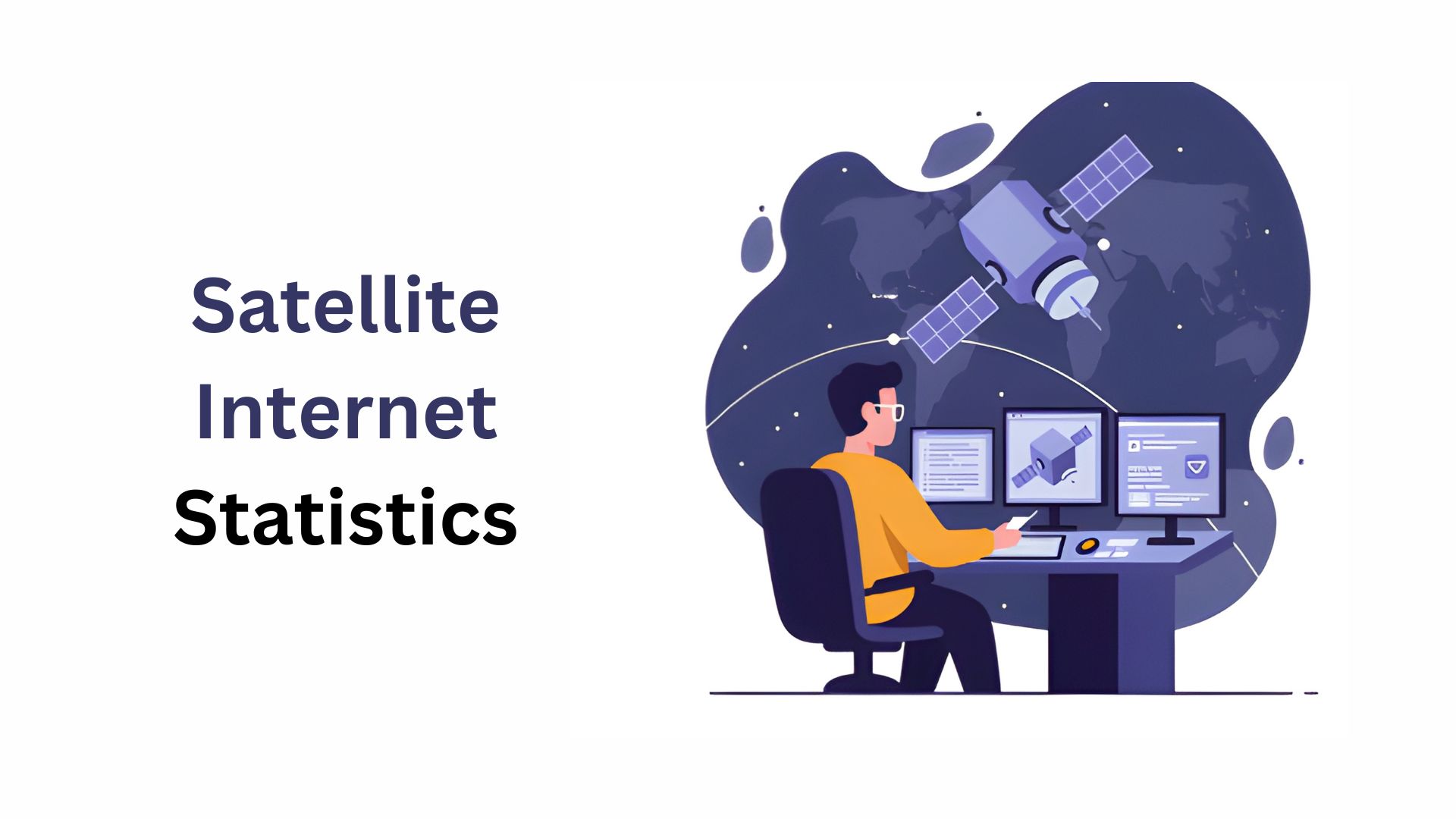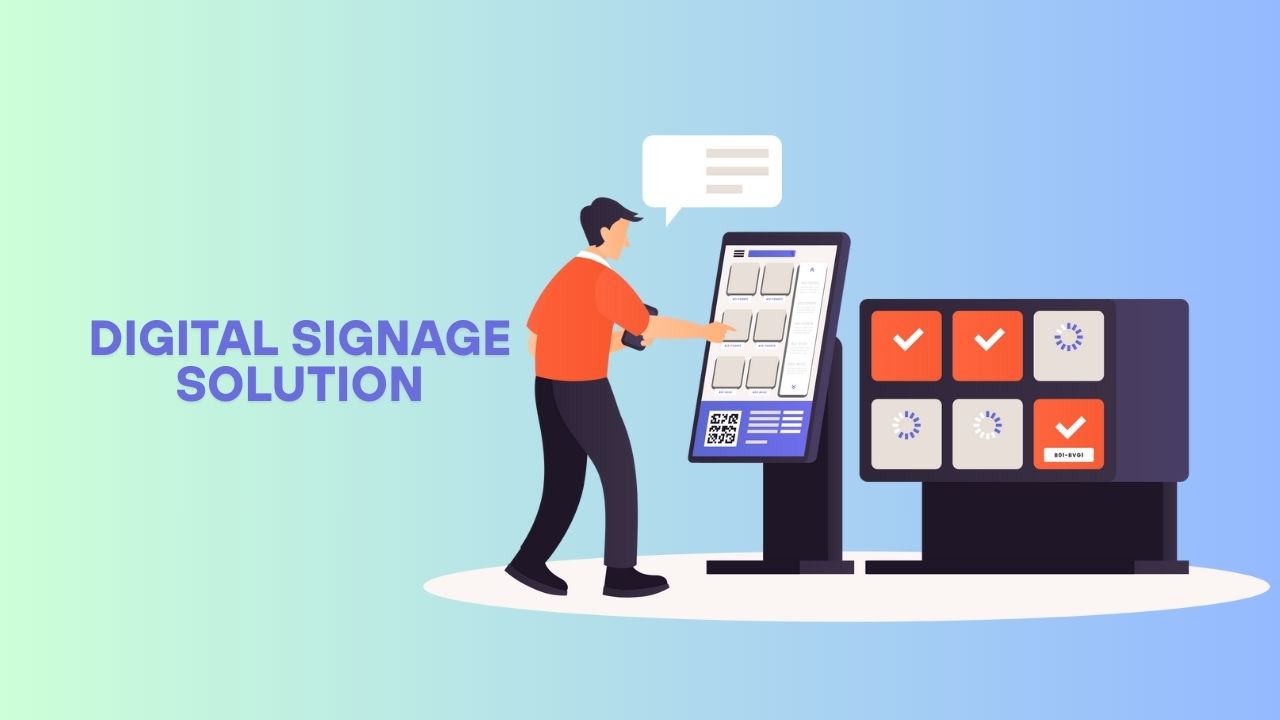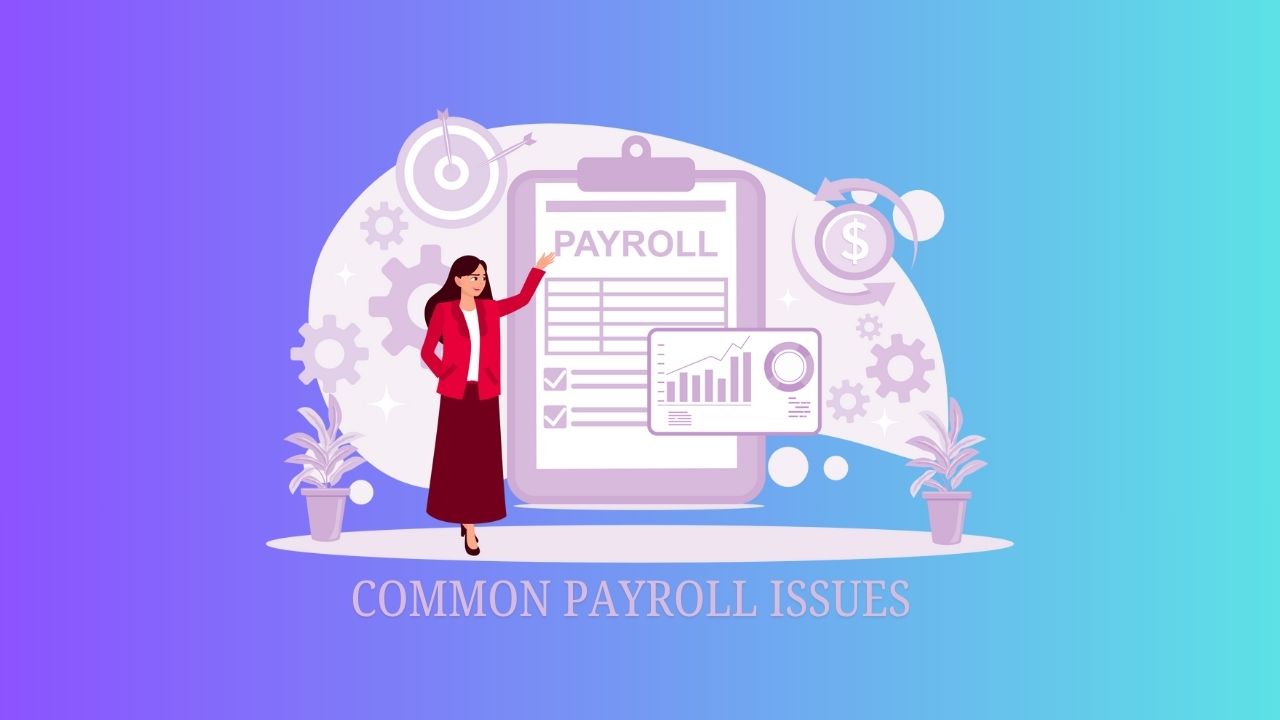Zapier Statistics And Facts (2025)
Updated · May 27, 2025
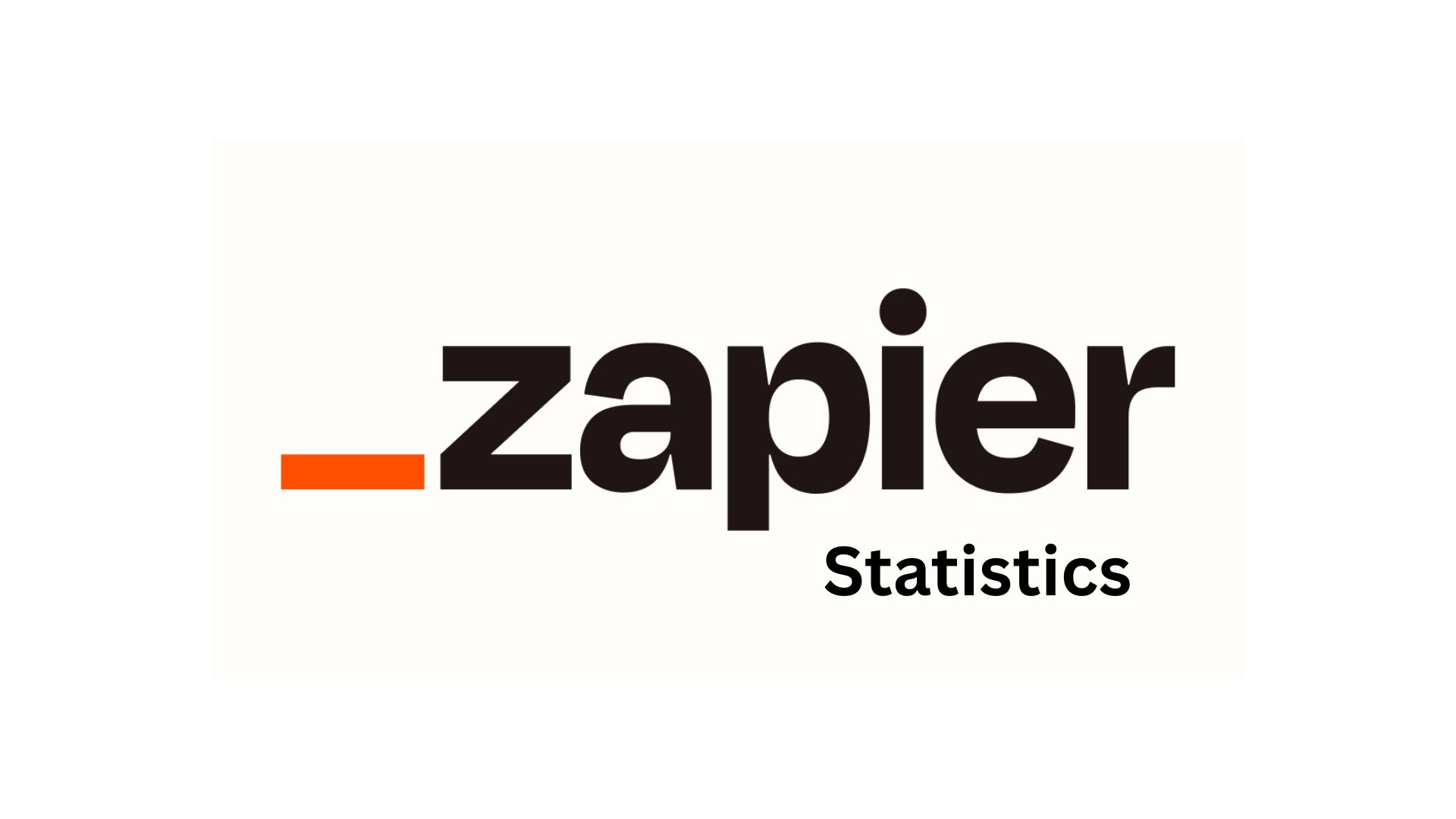
Table of Contents
Introduction
Zapier Statistics: Zapier, the no-code automation platform, truly revolutionised late-stage workflow automation, with over 7,000 apps to be linked. Founded in 2011, and after a few years of growth and waxing, the tool has become one of the rare platforms companies count on in converting efficiency into productivity.
Evidence of Zapier’s heavy footprint in 2024 is represented by its impressive revenue numbers, exploding user base, and stronger market presence. It thus steals the 2024 limelight through Zapier statistics that legitimise its performance and impact.
Editor’s Choice
- Zapier is a leading no-code automation platform founded in 2011 that connects over 7,000 apps and has become essential for businesses seeking to improve efficiency.
- Zapier revenue witnessed steady growth from US$150 million in 2021 to US$310 million in 2024 and is forecasted to double to US$400 million in 2025.
- In 2021, Zapier was valued at US$5 billion, with an ARR of US$165 million and a revenue multiple of 30.3x, even though it had raised only US$1.4 million previously.
- The company operates on a subscription SaaS model with tiered pricing depending on the number of automated actions, from a free level with limited access to over US$599 a month for full access.
- Zapier’s freemium model brings in over 3 million users, including 100,000 paying customers, whereby users can begin with limited two-step zaps before moving on.
- In an 18-month span, average customer lifetime value rose from US$400 to US$883, with ARPU increasing twofold, from US$20 to US$41.70, respectively, with an average contract value of around US$500.
- The count of integrations exploded—the figure almost doubled from 700 to 1,400, greatly benefiting customer adoption and retention.
- Zapier attempts to identify new integration opportunities by keeping tabs on app hiring trends and traffic.
- In 2017, team and enterprise plans were introduced, priced at US$250 and US$600 per month to retain larger customers.
- Churn, every month, is low, probably sub-5%, because the product is easy to use, highly scalable, and customers are actively engaged with personalised communication.
- Raising only US$1.4 million, Zapier has managed to outperform competitors such as IFTTT, which was able to raise above US$60 million, and Microsoft Flow, backing fewer integrations.
- One of the few 100% remote businesses with over 200 employees, the company boasts high retention, with eight out of the first 10 hires still working there.
Zapier Annual Revenue
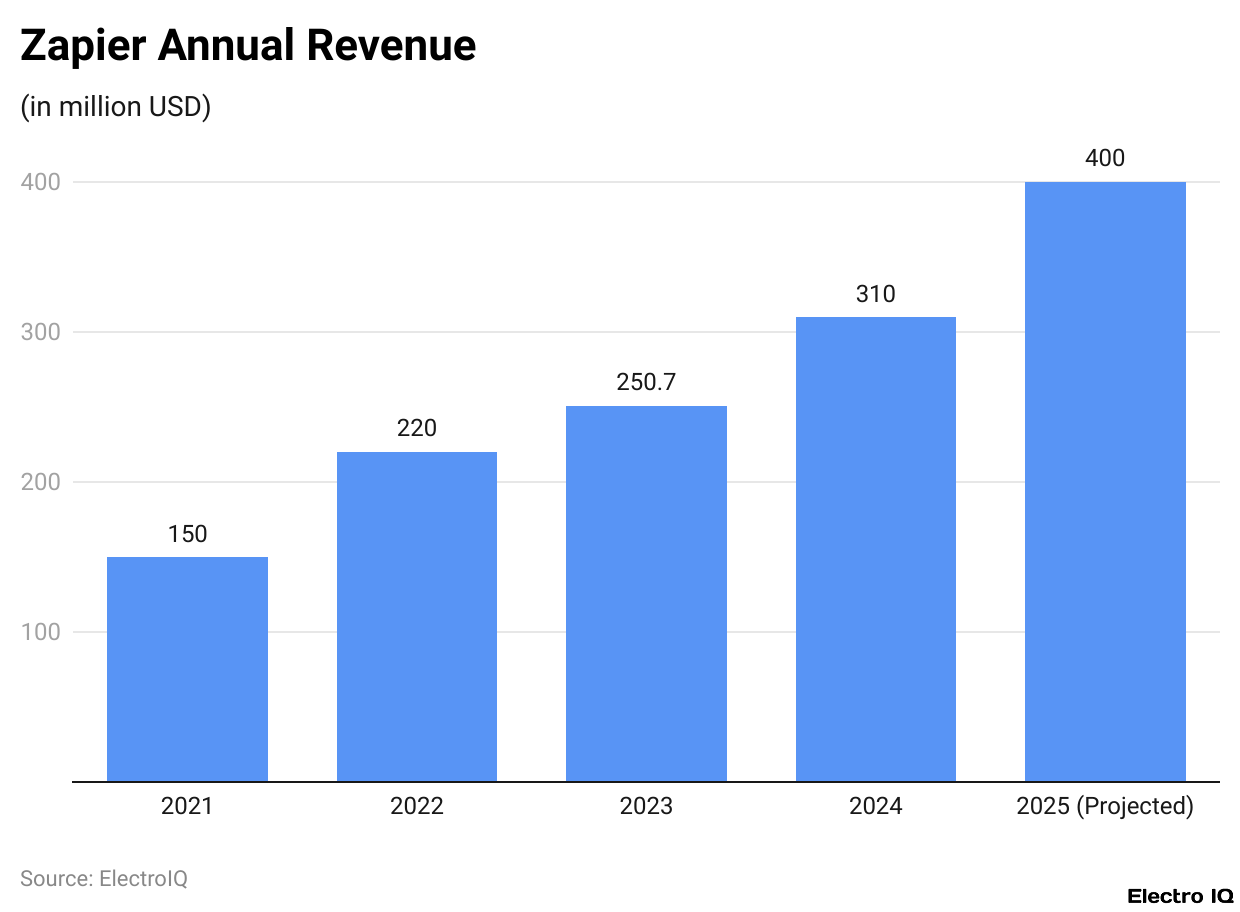
(Reference: taptwicedigital.com)
- According to Taptwice Zapier statistics, the revenue growth of Zapier from 2021 to 2024 remained agile and steady.
- Revenue clocked in at US$150 million in 2021.
- Then, 2022 saw an astronomical increase to US$220 million: a 46.7% growth on a year-to-year basis. Such a growth trend kept rolling on in 2023, when revenue rose to US$250.7 million, as a somewhat tempered yet still respectable increment of about 14% was recorded.
- And with 2024 around the corner, Zapier constructively saw its revenue hit US$310 million, revealing a 23.6% increase compared to the previous year.
Zapier Valuation
- According to Sacra Zapier statistics, in 2021, Zapier was valued at US$5 billion, with Sequoia Capital playing a key role in its funding.
- At the time, the company had an annual recurring revenue (ARR) of US$165 million, which meant it was operating at a revenue multiple of 30.3x—a figure that reflects high investor confidence and strong market positioning.
- Despite its impressive valuation, Zapier has remained capital-efficient, raising only US$1.4 million through three funding rounds.
- The company has attracted backing from major investors such as Sequoia Capital and Y Combinator, underscoring its strong reputation and growth potential in the tech and automation space.
Zapier Business Model
- Given the subscription nature of the business, Zapier is a SaaS company providing an automation platform connecting over 6000 applications.
- The lowest-tiered paid subscription can run from US$19.99 upward, into the hundreds, depending on huge volumes of automations and tasks.
- Zapier has achieved extraordinary capital efficiency on top of all this. Uplifted into a US$140 million ARR weighing business with just US$1.4 million in venture funding, it could rightly claim preeminence.
- From 2021 to 2024, Zapier’s revenue grew steadily at a phenomenal rate. The year 2021 saw revenue of US$150 million, which rocketed to US$220 million a year later: a 46.7% increase.
- During 2023, revenue grew to reach US$250.7 million, a somewhat moderate but still meaningful 14% rise.
- Zapier’s revenue grew to US$310 million in 2024, registering a 23.6% increase on the year. With a projected US$400 million in revenue for 2025, this would entail an expected growth of around 29% from 2024.
- Thus, this persistent growing trend depicts a strong demand for Zapier in the market, a growing customer base, and well-developed channel expansion strategies; Zapier has 100,000-plus paying customers and more than 3 million total users, thanks to its freemium model.
- The platform connects and automates tasks between 6,000+ apps through zaps, or trigger-based workflows, with limited access under the freemium option to lure users.
- The average Lifetime Value (LTV) of a customer in 18 months more than doubled, from US$400 to US$883, and Price Per User also doubled, from US$20 to US$41.70.
- With an average contract value of US$500, Zapier now stands alongside companies like GetResponse and Issuu of a similar size.
- Over 18 months, the company almost doubled app integrations-from 700 to 1,400-which helped increase usage and LTV. Zapier uses its data, such as hiring volumes and trending traffic, to spot which apps are up and coming for integration opportunities.
- Team and Enterprise plans were introduced in 2017 at US$250 for Teams and US$600 for Enterprise, boosting retention among larger customers.
- The churn rate remains below 5% every month, attributed to ease of use and scalable features that grow with the business.
- Zapier statistics show that Zapier has raised just US$1.4 million, whereas competitors such as IFTTT have raised US$60 million. Despite that, Zapier manages to outpace the 222 integrations supported by Microsoft Flow.
- Revenue went from US$14.4 million to US$50 million in 18 months, riding on partnerships with Airtable, Discord, Front, and Squarespace.
- Despite raising minimal funding, Zapier has managed to keep good relations with investors, appreciating their input to its strategic growth.
- The 200-person team, fully remote, is marked by high retention, with 8 out of the first 10 employees still constituting part of the work family.
- Remote work and documentation discipline are ingrained in the culture, creating an environment for autonomy and long-term employee happiness.
Zapier Website Traffic By Country
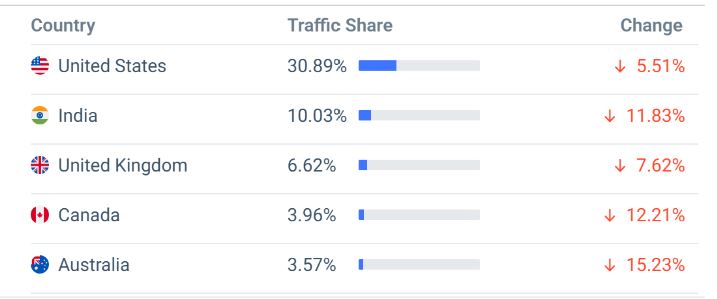
(Source: similarweb.com)
- According to the Similaweb Zapier statistics data on traffic for the website, the U.S. contributes the largest aggregate share, accounting for 30.89% of all traffic. Yet, this is down by 5.51%.
- India comes second at 10.03% of the traffic, but it too has fallen into a heavy decline of 11.83%.
- The U.K. stands at 6.62%, going down by 7.62%. Canada’s share is 3.96% and has seen a decline of 12.21%, and finally, Australia stands at 3.57% and is going down the fastest amongst all the top countries by 15.23%.
- This seems to indicate a decline in traffic in some of the major regions, possibly suggesting that user behaviour could be shifting, marketing focus might be changing, or that competition just might be intensifying.
Zapier Marketing And Social Media Traffic
- According to Zapier statistics, marketing performance data for Zapier, organic search is the main source of its website traffic, generating 48.79% of visits. This points toward a strong SEO presence, and probably being privileged by good content and keyword optimisation.
- Almost 40.18% is direct, where users are already aware of the brand and visit the site simply by typing the URL or accessing it through a bookmark.
- Paid search accounts for 6.26%, thereby showing some moderate activity in the realm of paid advertising.
- Referral traffic accounts for 3.05%, meaning that other websites send some traffic over to theirs.
- Display ads represent a very small portion of 0.11%, indicating their limited focus on banner advertising.
- Meanwhile, social media generates 1.56% of traffic, and email marketing just 0.05%, suggesting a little investment in these channels.
- Looking at social media sources in particular, LinkedIn leads with 29.19% of Zapier’s social traffic, serving as a testament to the company’s B2B emphasis.
- Coming in just after are the creators of almost 28.55%, showing that video content has an important role in their outreach effort.
- Facebook, with 22.25%, and Reddit, at 7.04%, are next. X (formerly Twitter) churns out 4.40%, while other platforms constitute the remaining 8.56%.
- Overall, the marketing strategy for Zapier seems to emphasise organic and direct channels that enjoy a strong professional presence on LinkedIn and YouTube.
Conclusion
In 2024, Zapier statistics marked its territory in the no-code automation industry with great revenue generation, an immense number of users, and a great rapport within the industry. It is the great culture of innovation, with the largest number of application integrations and a work-from-anywhere approach, that has propelled the company to where it sits today. With businesses vying for better automation solutions, the future spells growth and influence for the Zapier brand.
Sources
FAQ.
Founded in 2011, Zapier is a no-code automation platform that connects more than 7,000 apps, allowing businesses to automate workflows without coding. Revenues rose steadily from US$150 million to US$310 million between 2021 and 2024 and are projected to touch US$400 million in 2025. The platform currently has more than 3 million users, exceeding 100,000 who pay for the service.
Zapier operates on a subscription SaaS model, with tiered pricing according to the number of automated tasks and the complexity of integrations. It offers a freemium plan with limited two-step automations; paid plans range from US$19.99 to upwards of US$599 a month. Introduced in 2017, team and enterprise pricing plans enable support for larger organisations at US$250 per month and US$600 per month, respectively.
Despite very little funding of US$1.4 million, it has been able to accomplish more than competitors like IFTTT, with its more than US$60 million and fewer than 222 app integrations. Having grown its integration count nearly twofold from 700 to more than 1,400 in the past 18 months, customer usage and retention have increased drastically.
The lifetime value of Zapier customers rose from US$400 to US$883 in these 18 months, while the average revenue per user has doubled from US$20 to US$41.70. Also, the average contract value is around US$500. Maintaining a less than 5% churn rate monthly, the company keeps engaged customers, which is attributed to usability, scalability, and active customer outreach in the form of personalised email recommendations.
Search engines and direct hits have brought nearly 49% of the traffic to the Zapier site, indicating strong brand presence and SEO. The remaining percentage represents paid search, referrals, social media, and email marketing. The lion’s share of social media traffic consists of LinkedIn (29.19%) and YouTube (28.55%), proving Zapier’s orientation towards professionals and video content.

Tajammul Pangarkar is the co-founder of a PR firm and the Chief Technology Officer at Prudour Research Firm. With a Bachelor of Engineering in Information Technology from Shivaji University, Tajammul brings over ten years of expertise in digital marketing to his roles. He excels at gathering and analyzing data, producing detailed statistics on various trending topics that help shape industry perspectives. Tajammul's deep-seated experience in mobile technology and industry research often shines through in his insightful analyses. He is keen on decoding tech trends, examining mobile applications, and enhancing general tech awareness. His writings frequently appear in numerous industry-specific magazines and forums, where he shares his knowledge and insights. When he's not immersed in technology, Tajammul enjoys playing table tennis. This hobby provides him with a refreshing break and allows him to engage in something he loves outside of his professional life. Whether he's analyzing data or serving a fast ball, Tajammul demonstrates dedication and passion in every endeavor.


